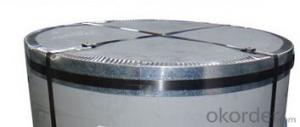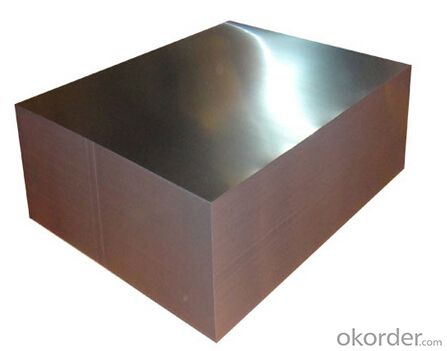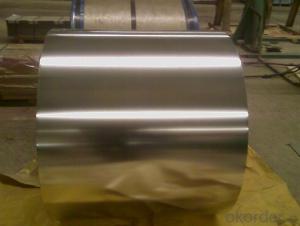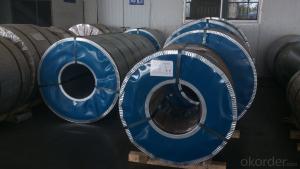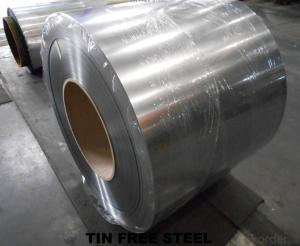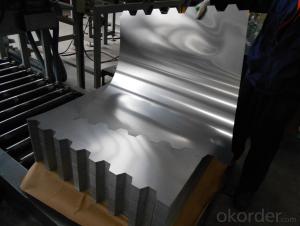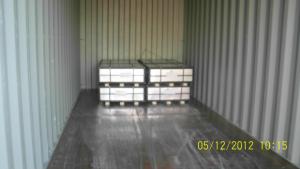TIN FREE STEEL SHEETS
- Loading Port:
- China Main Port
- Payment Terms:
- TT OR LC
- Min Order Qty:
- -
- Supply Capability:
- -
OKorder Service Pledge
OKorder Financial Service
You Might Also Like
We are one of the main producers in China for TFS. At present, our productivity is about 450000 MT/year. Tin Free Steel size:
TEMPER: T1-T5, DR7-9
ANNEALING:BA/ CA
THICKNESS: 0.15~0.45mm
WIDTH: 600~1050mm
The main product tinplate and tin free steel are metal package material widely used in food, light industry and chemical industry. We organize our production strictly in accordance with Q/ZYB E1、Q/ZYB E3、GB/T252, GB/T24180, JIS G3303, JIS G3315 and ISO11950 or equivalent standards. Companies adhere to principles of quality, food safety, environment, occupation, health safety and energy, say "excellent quality to win the trust of customers, health and safety to gain the trust of the public, clean environment to harvest the trust of the community, safety and health to convince employees and energy-saving to be trusted by public". We are enjoying the trust and good name regarding to the superior quality and prefer service among the customers. Our products are sold nearly 150 enterprises including Europe, America, Oceania, Middle East and Southeast Asia.
Company management system is healthy, operational mechanism running good. After years of effort, base on the introduction, absorption, digestion of the advanced technology, techniques, equipment, we gradually set up the unique production process and technical support system which is market need-oriental and suite to the Chinese condition. In the fierce market competition, our company will continue to pursue the excellence quality and outstanding service, and provide more and better service and service to meet customers demand on metal package home and abroad.
- Q: What are the common storage and handling requirements for tinplate?
- Common storage and handling requirements for tinplate include keeping it in a dry and clean environment to prevent corrosion, avoiding exposure to extreme temperatures, and ensuring proper stacking to prevent damage to the material. It is also important to handle tinplate with care to avoid any bending or scratching that could affect its quality and appearance.
- Q: What are the advantages of using tinplate in packaging?
- There are several advantages of using tinplate in packaging. Firstly, tinplate is highly durable and resistant to corrosion, ensuring product protection and extending shelf life. It also provides excellent barrier properties against light, oxygen, and moisture, preserving the quality and freshness of the packaged goods. Additionally, tinplate is lightweight, making it easy to handle and transport. Furthermore, it is a sustainable and recyclable material, contributing to environmental sustainability and promoting a circular economy. Lastly, tinplate offers a versatile and customizable packaging solution, allowing for attractive designs and branding opportunities.
- Q: What are the main applications of tinplate in the pharmaceutical industry?
- Tinplate is primarily used in the pharmaceutical industry for packaging purposes. Its main applications include the production of tinplate cans, containers, and closures. These tinplate packaging solutions provide a reliable and durable barrier against moisture, light, and oxygen, ensuring the protection and preservation of pharmaceutical products. Additionally, tinplate is also used for labeling and promotional purposes due to its excellent printability and aesthetic appeal.
- Q: How long does tinplate last?
- Tinplate can last for several decades, or even longer, depending on various factors such as the quality of the tin coating, the environment it is exposed to, and the maintenance practices followed.
- Q: What are the applications of tinplate?
- Tinplate has a wide range of applications due to its protective and aesthetic properties. Common uses include packaging cans for food and beverages, aerosol containers, metal caps and closures, electrical components, and even decorative items. Its corrosion resistance and ability to maintain product freshness make it a popular choice for preserving and packaging various goods.
- Q: How does tinplate compare to plastic packaging?
- Tinplate packaging offers several advantages over plastic packaging. Firstly, tinplate is more durable and can withstand higher temperatures, making it suitable for preserving food and beverages. It also provides better protection against external factors such as sunlight, moisture, and oxygen, thus ensuring the longevity and quality of the contents. Additionally, tinplate is fully recyclable and has a higher recycling rate compared to plastic, making it a more sustainable choice. Lastly, tinplate packaging has a premium appearance that can enhance the product's perceived value and appeal to consumers.
- Q: How does the tin coating affect the weldability of tinplate?
- The tin coating on tinplate improves the weldability of the material. It acts as a protective layer, preventing oxidation and promoting better adhesion during the welding process. This ensures a stronger and more reliable weld.
- Q: Can tinplate packaging be used for pet food products?
- Yes, tinplate packaging can be used for pet food products. Tinplate is a commonly used material for packaging due to its durability, resistance to corrosion, and ability to maintain the freshness and quality of food products. It provides a secure and protective barrier against external elements, making it suitable for pet food products as well.
- Q: What are the different closure mechanisms for tinplate cans?
- Some different closure mechanisms for tinplate cans include friction lids, easy-open ends with pull tabs, twist-off caps, and can seaming.
- Q: What are the different methods of labeling and branding on tinplate packaging?
- There are several methods of labeling and branding on tinplate packaging, including lithography, embossing, printing, and metal etching. Lithography is a popular method that involves applying ink onto the tinplate through a printing process. Embossing creates raised or recessed designs on the surface of the tinplate, adding texture and visual appeal. Printing involves directly printing the design onto the tinplate using various techniques such as screen printing or digital printing. Metal etching is another method where the design is chemically etched onto the tinplate, resulting in a durable and long-lasting branding.
Send your message to us
TIN FREE STEEL SHEETS
- Loading Port:
- China Main Port
- Payment Terms:
- TT OR LC
- Min Order Qty:
- -
- Supply Capability:
- -
OKorder Service Pledge
OKorder Financial Service
Similar products
Hot products
Hot Searches
Related keywords
